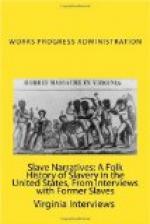I don’t know what town we were near. The only town I know about had only about four or five houses and a mill. I think the name was Fairfield. That may not be the name, and the town may not be there any more. Once they sent my mother there in the forenoon. She saw a flash, and something hit a big barn. The timbers flew every way, and I suppose killed men and horses that were in the barn. There were Rebels hidden in the barn and in the houses, and a Yankee spy had found out where they were. They bombed the barn and surrounded the town. No one was able to leave. The Yankees came and captured the Rebels.
I had a cousin named Jerry. Just a little while before the barn was struck a white man asked Jerry how he would like to be free. Jerry said that he would like it all right. The white men took him into the barn and were going to put him over a barrel and beat him half to death. Just as they were about ready to beat him, the bomb struck the barn and Jerry escaped. The man who owned us said for us to say that we were well enough off, and did not care to be free, just to avoid beatings. There was no such thing as being good to slaves. Many people were better than others, but a slave belonged to his master and there was no way to get out of it. A strong man was hard to make work. He would fight so that the white men trying to hold him would be breathless. Then there was nothing to do but kill him. If a slave resisted, and his master killed him, it was the same as self-defense today. If a cruel master whipped a slave to death, it put the fear into the other slaves. The brother of the man who owned my mother had many black people. He was too mean to live, but he made it. Once he was threshing wheat with a ‘ground-hog’ threshing machine, run by horse power. He called to a woman slave. She did not hear him because of the noise of the machine, and did not answer. He leaped off the machine to whip her. He caught his foot in some cogs and injured it so that it had to be taken off.
They tell me that today there is a place where there is a high fence. If someone gets near, he can hear the cries of the spirits of black people who were beaten to death. It is kept secret so that people won’t find it out. Such places are always fenced to keep them secret. Once a man was out with a friend, hunting. The dog chased something back of a high fence. One man started to go in. The other said, “What are you going to do?” The other one said, “I want to see what the dog chased back in there.” His friend told him, “You’d better stay out of there. That place is haunted by spirits of black people who were beaten to death.”
Federal Writers’ Project
of the W.P.A.
District #6
Marion County
Anna Pritchett
1200 Kentucky Avenue
Folklore
Mrs. Sarah H. Locke—daughter
[of Wm. A. and Priscilla Taylor]
Mrs. Locke, the daughter of Wm. A. and Priscilla Taylor, was born in Woodford County, Kentucky in 1859. She went over her early days with great interest.




